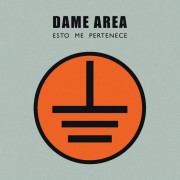Formed in 2017 within the vibrant underground scene of Barcelona’s Màgia Roja club, Dame Area comprises the Italian-Catalan duo Silvia Konstance and Viktor Lux Crux. They fuse industrial-tribal polyrhythms with minimalist synth basslines, drawing profound inspiration from avant-garde masters such as Esplendor Geometrico, Throbbing Gristle, Suicide, Einstürzende Neubauten, Can, Coil, Swans, Big Black, and Wolf Eyes.
|
The essence of Dame Area – the project of Barcelona-based duo Silvia Kostance and Viktor L. Crux – is formidable, volatile, unpredictable. Across two albums and several EPs, Dame Area have executed an eclectic, discerning form of contemporary industrial music, deploying compulsive minimal synth and primal polyrhythms, as well as uniquely reconstrued elements of post-punk & EBM. An artistic identity that embraces influence yet eschews compromise. Upholding the assaultive intensity of their renowned live shows, Dame Area’s third album ‘Toda la mentira sobre Dame Area’ / ‘All the Lies about Dame Area’ nevertheless discloses unexpected developments, a work distinguished by innovation and classicism, discordance and melodicism, the grit of a basement club and the gleam of a radical discotheque. The first of two twin LPs, ‘Toda la mentira sobre Dame Area’ illustrates one world within the wider universe of Dame Area, an album of paradox, which finds the duo at their most explicit and emphatic, but which also sees them detour, into some of their most experimental material to date. Across eight tracks, Dame Area assert an original, seductive idea of pop, laced with avant-garde subversion. Gridlocked minimal synth mechanics are riven with insurgent noise and dub echoes on ‘La Nueva Era’ (‘The New Era’) while the fierce hedonism of ‘Innamorata del tuo Controllo’ (‘In Love with your Control’) evokes striking alternative histories; Gino Soccio meets Deutsch Amerikanische Freundschaft, the Italo years of Liaisons Dangereuses, Nitzer Ebb reworked by Bobby O. Conversely, the disarming finale ‘A volte me sembra’ (‘Sometimes it seems to me’) is dreamlike and winsome, the sound of an auspicious horizon, hitting the sweet spot somewhere between Chris & Cosey’s ‘October Love Song’, the Dorothy ‘I Confess’ 7” on Industrial Records, as well as the finer moments of Martin Dupont and early Human League. Yet throughout these highlights and beyond, Dame Area establish their own voice, as vivid derivation becomes transformation and inspirations are redefined. Dame Area have been accurately described as purveyors of combat music – ‘Música de lucha’ – rather than producers of dance music. This holds true on ‘All the Lies about Dame Area’. However, their sense of contention here is expansive and dynamic. ‘All the Lies about Dame Area’ is a record of tension and surprise, where the distinction between melody and abstraction is thrillingly undetermined. A provocative record for the here and now, which proves Dame Area are never easily contained. Dame Area ended 2021 and has started 2022 acclaimed in the european stages with a live show praised for its power and darkness, made up of many new tracks. Some of those have been gathered in this EP. Industrial music with a touch of EBM without ortodoxy nor cobwebs, with metallic percussions performing some atypical rhythms and Suicide’s minimalist spirit overflying the scene. Probably Dame Area’s most dance-floor oriented record till the date, “Esto me pertenece” is not simply “dance music” but combat music instead. In fact it doesn’t lose sight of the fact that what’s most important are not the fat kicks, the unrelenting synths or the percussion, but the attitude. And in spite of the patent darkness of the record there is a clear call to arms to claim what belongs to us: the present. The Barcelona’s duo explore their more industrial (as in early industrial, not industrial noise) and minimal synth facets. Tribal elements are kept to just a couple of tracks. Metallic percussion, throbbing synths and arpeggios living together under the same roof. This release has it all: rhythm, experimentation and melody. FFO: Throbbing Gristle, Diseño Corbusier, Chris and Cosey, Liasons Dangerouses, Einstürzende Neubauten, Soft Moon, Cabaret Voltaire, Essaie Pas, DAF. Dame Area is an industrial tribal experimental duo from Barcelona. Imagine the past, remember the future.
12
|





